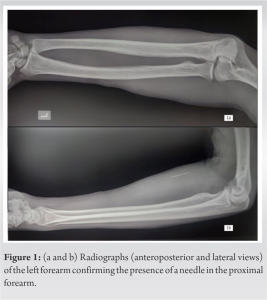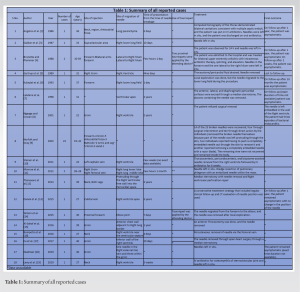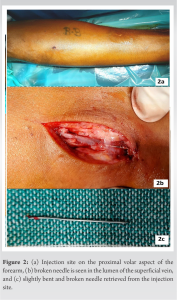Intraluminal intravenous needle breakage should be dealt with like an emergency, as there is a risk of migration of the needle fragment to proximal sites in the body.
Dr. Nitish Bansal, Department of Orthopaedics, GMC, Patiala, Punjab, India. E-mail: nitishbansal88@gmail.com
Introduction: Intravenous injections are an everyday practice in the health-care sector and are also frequently abused by drug abusers. One rare complication of intravenous injections is venous intraluminal breakage of the needle, which is a matter of concern due to the possible embolization of needle fragments in the body.
Case Report: We report our case of an intravenous drug abuser with an intraluminal breakage of a needle presenting within 2 h of the incidence. The broken needle fragment was retrieved successfully at the local injection site.
Conclusion: Intraluminal intravenous needle breakage should be treated as an emergency, and a tourniquet should be applied as soon as possible.
Keywords: Intravenous, drug abusers, intraluminal needle breakage, needle retrieval.
Intravenous injections are an everyday practice in the health-care sector and are also frequently abused among drug abusers. According to a 2019 report published by the Ministry of Social Justice and Empowerment of the Government of India, India has an estimated 8.5 lakh intravenous drug abusers [1]. A substantial proportion of them report risky injecting practices. About half reported reusing their needles and syringes, and about a third reported experiencing vein-related complications, ulcers, and abscesses at the injecting sites [1]. Intraluminal breaking of the needle is a rare complication that should be taken seriously because it could result in the embolization of needle fragments. We are reporting the case of a young man with a history of intravenous injection of heroin using a reused needle resulting in its breakage inside the lumen of the proximal forearm vein.
A 28-year-old male, right-hand dominant, an intravenous drug abuser for the past 5 years, presented to the orthopedics emergency department of our hospital with a history of pain, redness, and swelling in his left proximal forearm from the past 2 h. The patient admitted to injecting heroin into his left proximal forearm vein with a multiple times reused syringe and that the needle broke while injecting the drug. Immediately, a tourniquet was applied at the level of the midarm by the patient himself to prevent embolization of the needle. Radiographs (AP and Lateral view) of the left forearm confirmed the presence of a broken needle in the mid-left proximal forearm (Fig. 1a and b). 
There are several instances reported of intraluminal breakage of the needle in intravenous drug abusers (Table 1).
Intraluminal intravenous needle breakage should be dealt with like an emergency, as there is a risk of migration of the needle fragment to proximal sites in the body. A tourniquet should be applied as soon as possible to avoid proximal migration of the needle.
Intravenous drug abusers should be educated about safe injection practices and should be sensitized about reporting to the emergency as soon as there is needle breakage.
References
- 1.Ambekar A, Agrawal A, Rao R, Mishra AK, Khandelwal SK, Chadda RK. Magnitude of Substance use in India. New Delhi: AIIMS; 2019. Available from: https://www.aiims.edu/en/national-drug-use-survey-2019.html [Last accessed on 2023 Jan 28]. [Google Scholar]
- 2.Angelos MG, Sheets CA, Zych PR. Needle emboli to lung following intravenous drug abuse. J Emerg Med 1986;4:391-6. [Google Scholar]
- 3.Galdun JP, Paris PM, Weiss LD, Heller MB. Central embolization of needle fragments: A complication of intravenous drug abuse. Am J Emerg Med 1987;5:379-82. [Google Scholar]
- 4.Brunette DD, Plummer DW. Pulmonary embolization of needle fragments resulting from intravenous drug abuse. Am J Emerg Med 1988;6:124-7. [Google Scholar]
- 5.Gyrtrup HJ, Andreassen KH, Pedersen JH, Mortensen LB. Central embolization of needle fragment following intravenous drug abuse. Br J Addict 1989;84:103-5. [Google Scholar]
- 6.Kulaylat MN, Barakat N, Stephan RN, Gutierrez I. Embolization of illicit needle fragments. J Emerg Med 1993;11:403-8. [Google Scholar]
- 7.LeMaire SA, Wall MJ Jr., Mattox KL. Needle embolus causing cardiac puncture and chronic constrictive pericarditis. Ann Thorac Surg 1998;65:1786-7. [Google Scholar]
- 8.Ngaage DL, Cowen ME. Right ventricular needle embolus in an injecting drug user: The need for early removal. Emerg Med J 2001;18:500-1. [Google Scholar]
- 9.Norfolk GA, Gray SF. Intravenous drug users and broken needles--a hidden risk? Addiction 2003;98:1163-6. [Google Scholar]
- 10.Steiner J, Dhingra R, Devries JT. Needle in the haystack: Purulent pericarditis from injection drug use. Catheter Cardiovasc Interv 2012;80:493-6. [Google Scholar]
- 11.Monroe EJ, Tailor TD, McNeeley MF, Lehnert BE. Needle embolism in intravenous drug abuse. Radiol Case Rep 2015;7:714. [Google Scholar]
- 12.Thanavaro KL, Shafi S, Roberts C, Cowley M, Arrowood J, Cassano A, et al. An unusual presentation of chest pain: Needle perforation of the right ventricle. Heart Lung 2013;42:218-20. [Google Scholar]
- 13.Danek BA, Kuchynka P, Palecek T, Cerny V, Hlavacek K, Lambert L, et al. Needle fragment embolism into the right ventricle: A rare cause of chest pain case report and literature review. Wien Klin Wochenschr 2016;128:215-20. [Google Scholar]
- 14.Wilson RJ, Crosby SN, Lee DH. Removal of a venous intraluminal needle: A case report. J Hand Microsurg 2015;7:170-2. [Google Scholar]
- 15.Al-Sahaf M, Harling L, Harrison-Phipps K, Bille A. An unusual case of needle embolus presenting with delayed spontaneous pneumothorax. Ann Thorac Surg 2016;102:e201-3. [Google Scholar]
- 16.Bompotis G, Karkanis G, Chatziavramidis A, Konstantinidis I, Dokopoulos P, Lazaridis I, et al. Percutaneous removal of a tiny needle fracture from the right ventricle of the heart in a drug abuser. Vasc Endovascular Surg 2016;50:575-8. [Google Scholar]
- 17.Fu X, Chen K, Liao X, Shen K. Case report: Surgical removal of a migrated needle in right ventricle of an intravenous drug user. Subst Abuse Treat Prev Policy 2017;12:51. [Google Scholar]
- 18.Gladman J. Pins and needles in the groin: An incidental finding of retained needle fragments in an intravenous drug user. BMJ Case Rep 2019;12:e226220. [Google Scholar]
- 19.Levy M, Hahn B, Aycock R. Needle embolization: Suspecting needle migration in intravenous drug abusers. J Emerg Med 2019. [Google Scholar]










